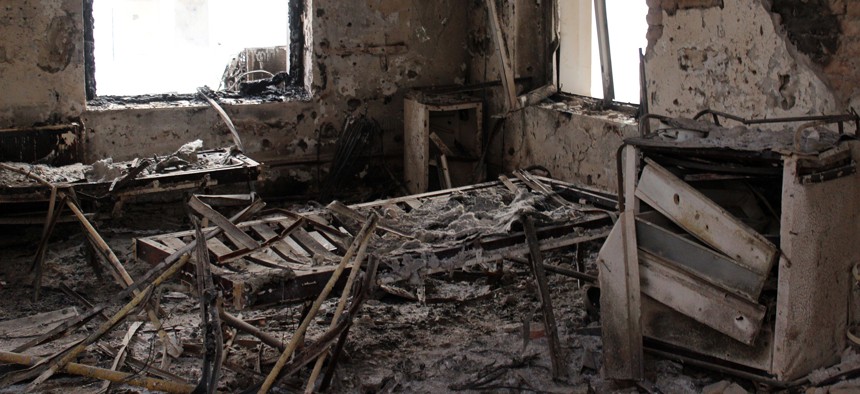
In this Friday, Oct. 16, 2015 photo, the charred remains of the Doctors Without Borders hospital is seen after it was hit by a U.S. airstrike in Kunduz, Afghanistan. Najim Rahim via AP
Eyes On Target ‘Not Required’ For Airstrikes Like the One On Kunduz Hospital
Military gunships are loaded with expensive sensors to hit targets. But that’s not the same as knowing what to hit.
A lesson is emerging from last month’s tragic U.S. airstrike in Afghanistan that killed at least 30 people at the Kunduz Trauma Center: having human eyes on the target when calling in air support can prevent innocent people from dying. Despite this, the military does not always require “eyes on” the target before an commander can call in a strike with an AC-130, one of the most dangerous weapons in the U.S. arsenal.
The U.S. Special Forces commander who phoned in the strike on the Kunduz Trauma Center was a half-mile away from the hospital at the time he made the call, the AP yesterday reported, according to one former intelligence official who had seen documents related to the incident. The story follows previous reports from the New York Times stating that U.S. special operators in fact did not have “eyes on” the target when ordering the airstrike, suggesting that a joint terminal attack controller, or JTAC, was not physically in the vicinity.
Defense One asked Air Force Special Operations Command, or AFSOC, for clarification as to whether JTAC “eyes on” were required for an AC-130 airstrike. AFSOC public affairs specialist Erica Vega responded, essentially, no: “Military doctrine defines and requires several types of control measures for Close Air Support. Visual acquisition of a target is one of many possible control measures to ensure safe and effective employment of Close Air Support. JTAC's are not required to visually acquire a target prior to an engagement if other control measures are in place,” she wrote in an email.
The military’s manual for calling in close air support points out that a JTAC with direct line of sight to a target is always preferable. “[Close Air Support] in support of stability operations often depends heavily on detailed and timely intelligence, detailed coordination with the maneuver commander’s plan, appropriate munitions, and JTAC with ‘eyes on’ the intended target.”
Modern AC-130s are outfitted with GPS and an inertial navigation system, as well as infrared and synthetic aperture strike radar that can acquire targets at long distances. The plane can hit multiple moving targets at once via a variety of systems radar, laser, and coordinates uplinked to the inertial navigation system, or thermal cameras. The presence of so much sensing and targeting tech is one possible reason why the Pentagon may have substituted “eyes half a mile away” for “eyes on.”
“Ideally, a JTAC would have eyes on the target, but that is not necessary with the advanced sensors and communications between the AC-130 and the JTAC on the ground," said Mike Haytack, a retired Air Force JTAC, last month.
Yet, acquiring a target with radar or thermal imaging is very different from determining whether or not the target is appropriate to kill.
As The Daily Beast originally reported, the military “actually requires relatively little scrutiny of the target area before [AC-130] gunship crews opens fire, compared to the much greater restrictions the Defense Department imposes on the pilots of other aircraft types.”
A series of documents from the Joint Staff obtained by the ACLU under a Freedom of Information Act Request carves out a number of exceptions for rules regarding collateral damage estimation and targeting, depending on factors including the type of weapon used (105mm or Howitzer grade and smaller) and conditions on the ground.
So what happened in this case?
The Special Forces unit whose commander called in the strike, “was under fire in the Kunduz provincial governor’s compound,” at the time, according to the AP.
Gen. John Campbell, top Afghanistan War commander, said in October at the Pentagon, “the Afghans asked for air support from a Special Forces team that we have on the ground providing train, advise and assist in Kunduz. The initial statement that went out was that U.S. forces were under direct fire contact. What I'm doing is correcting that statement here.”
This could happen again. President Obama announced last month the U.S. would keep 9,800 military personnel in Afghanistan through 2016, in part to support Afghan forces "in extremis", essentially in extreme danger. That means more potential for U.S. close air support for Afghan forces, Campbell testified. The stage is set for a smaller United States military presence rushing to protect Afghan forces with airpower in situations where those forces are less likely to have familiarity with facts on the ground.
“My question is, who was the Afghan on the radio?” one Navy SEAL who served in Afghanistan told Defense One. “Calling in an air strike, it’s a very rigid process. It’s step by step by step … You have to go to school. Where was the nearest JTAC qualified?”
It’s a question that critics have been asking for more than a month. Many more questions remain.





